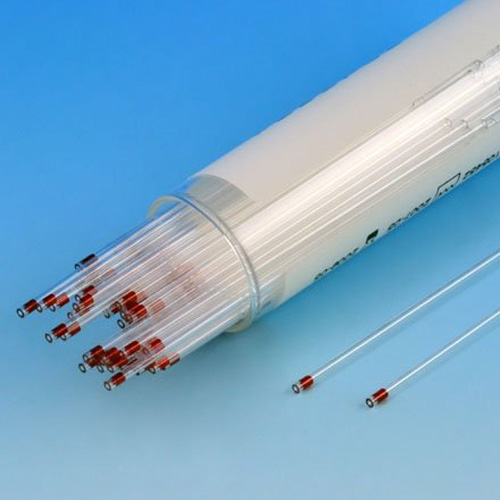Haematocrit Capillaries Heparinized
₹2,900.00 ₹190.00
| Brand | Recombigen |
| Manufacturer | Recombigen |
| Country of Origin | India |
| Quantity | 1 bottle 100pcs |
| Total Quantity | 1 Bottle |
1. Cleanliness is preserved by being packaged in polypropylene vials with reclosable snap-lock closures.
2. Flame or sealing clay can be used to seal ends.
3. Red-coded capillary tubes are heparinized to stop blood clotting.
4. Sodium identification is unaffected by ammonium heparin.
5. Tubes are produced using 90-expansion soda lime glass in accordance with USP Type III specifications.
6. available as a custom order in borosilicate glass
We are the prominent manufacturer, trader and supplier of the best range of Haematocrit Capillaries Heparinised. The offered products find application in medical centers. These products are manufactured using the best-grade raw material and sophisticated technology under the supervision of skilled professionals following the set industry parameters. In addition to this, we offer these products to our precious clients at market-leading prices.
Hematocrit capillaries are thin, transparent tubes typically made of glass or plastic. They have calibrated markings along their length to accurately measure the volume of blood and the resulting hematocrit value. The capillaries are filled with blood using a micro hematocrit centrifuge, where the blood is spun at high speed to separate the red blood cells from the plasma. The hematocrit value is then determined by measuring the length of the packed red blood cells in relation to the total length of the blood column in the capillary tube.
FAQ
Microhematocrit capillary tubes are the most popular capillary tubes for hematocrit measurements. It is a tiny, transparent tube made of glass or plastic that is typically between 75 and 100 millimetres long and 1.1 to 1.2 millimetres in inner diameter.
Precision measurements of blood volume and hematocrit values are possible because to the calibrated markings along the length of microhematocrit capillary tubes. These capillary tubes are used in conjunction with a microhematocrit centrifuge. Blood is drawn into the capillary tube, which is then centrifuged to separate the red blood cells from the plasma. The packed red blood cell length is compared to the length of the blood column in the capillary tube to calculate the hematocrit value.
Hematocrit assays do not commonly employ EDTA (ethylenediaminetetraacetic acid). For a variety of laboratory investigations, EDTA is frequently employed as an anticoagulant in blood collection tubes. Interacting with calcium ions, which are required for the clotting process, it aids in preventing blood clots.
A microhematocrit capillary tube is normally used to collect a small amount of blood for hematocrit tests. The red blood cells and plasma are separated from the blood sample using centrifugation. Since the blood is drawn straight into the capillary tube and the separation is accomplished through centrifugation, no anticoagulant is required in this procedure.
You must be logged in to post a review.

 Rapid Diagnostic Products
Rapid Diagnostic Products Serology Products
Serology Products Clinical Lab Accessories
Clinical Lab Accessories OTC Products
OTC Products Water Quality Test Kit
Water Quality Test Kit 










Reviews
There are no reviews yet.